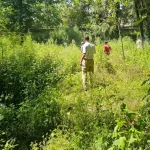Srinagar, May 04: The first photographic evidence of the fragile Western Tragopan from Jammu and Kashmir has been captured by bird enthusiasts in Kashmir.
The western Tragopan (Tragopan melanocephalus) is a medium-sized brilliantly plumed pheasant found along the Himalayas from Pakistan’s Khyber Pakhtunkhwa region in the west to India’s Uttarakhand in the east. The species is critically endangered all across the world.
The local Bird-Watching Club, Kashmir Birdwatch, confirmed the bird sighting in the valley, claiming it is the first photographic evidence of the Western Tragopan from J&K.
According to Intesar Suhail, co-founder of Kashmir Birdwatch, this is the first time the bird has been shot and videographed in Kashmir.
“Although the bird is well known to exist here, it is a very shy bird that is rarely seen in the wild.” “Previously, the only evidence we had was photographs of captive birds or dead specimens,” he explained.
The photograph was captured by a team of photographers including the famous bird photographer Jainy Maria and Valley-based Professional Wildlife Guide, Mudasir Manzoor.
“The same person who photographed it here has photographed it in Himachal Pradesh. It is a very shy and intelligent bird and rarely seen,” Suhail said.
He said that before the photographers went in pursuit of the bird, they consulted him and he, based on his experience and knowledge, briefed them about the possible locations where the bird could be found.
“The bird is easier to be heard than to be sighted and it is even more difficult to photograph it. In 2000, while I was doing a wildlife survey in one of our Protected Areas, I heard the breeding call of this bird and subsequently, got regular reports of the calls from that area,” he said.
Suhail said that the exact location of the bird sighting in the Kashmir Himalayas is not revealed owing to the poaching threats. “It is the breeding season for the bird right now and they are very vocal during this time,” he said. In the past, some reports suggested the sighting of the bird but it remained unconfirmed.
While talking about the features of the bird, Suhail said, the Western Tragopan nests in tree hollows not very high above the ground and uses thick bushes and foliage as cover.
“Naturally, forest fires are very detrimental to its survival. That’s why we need to protect its habitats from forest fires and other anthropogenic factors. Particularly in the breeding season, it should not be disturbed, and the threat can also come in the form of Gucchicollectors who often forage into dense forest glades to collect the wild mushrooms,” he said.





